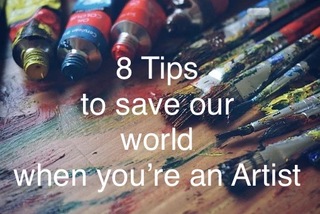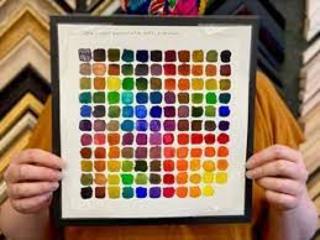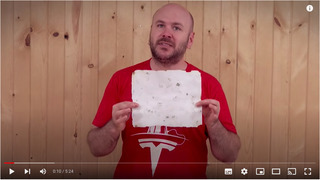8 tips to save our World when Youre an Artist
What's Going On In The World?
A lot is being said about global warming, we experience severe weather, and we hear people saying that the point of no return is fast approaching. This is because we will not be able to save certain aspects of our planet if we keep doing what we're doing and turning a blind eye to eco-friendly practices.
Unfortunately, our longstanding traditional art practices and the materials we use can be toxic to our health and the planet.
I've just finished watching another documentary on the devastation we humans inflict on earth. It took some time to reflect on the fact that we, as individuals, often feel helpless. Therefore don't do anything about it. Although some of us have sustainable practices, most have yet to learn where to start.
The protesters say there must be something we can do; Greta Thunberg is certainly doing her part; she's being seen and heard. Her quotes include -
-
“We must change almost everything in our current societies
-
“I don't want you to be hopeful, I want you to panic”
-
“Homo Sapiens have not yet failed
-
“Some people say that the climate crisis is something we have all created
However, does she actually tell you what you can do?
Do the documentaries tell us what we 'as individuals' can do to play our part?
They tell us what is happening because of our ignorance and greed; they show us the devastating effects our throwaway society has on our planet and what we are doing wrong. But, still, they often neglect to tell us what small changes we can start with as one person to help this global crisis. That is the key to me.
Today I am starting with me.
Even though I recycle, reuse, and have sustainable practices, I know there needs to be more than just me to achieve sustainability. Like you, I have a circle of influence. I know other artists, and I can help spread the word in the hope they, too, will start utilising some of these ideas.
I also hope they will spread the word to their network of other artists.
The more we share this knowledge, the more we can help save our beautiful planet for future generations. As an artist too, why create beautiful things if no one is likely to be around to appreciate them? Now, there's some food for thought!
Most artists care about the environment and want to help keep things green. So here is where you can start.
My 8 Tips to help save the planet as an Artist
- Start investing in eco-friendly paints/mediums and solvents
- Use ethically sourced or synthetic brushes
- Dispose of waste art materials properly
- Recycling and upcycling with your art materials
- Start using sustainable packaging materials
- Try making your own paints, paper and other art supplies
- Utilise other eco-friendly supplies
- Share unneeded art supplies with other artists, but most of all, share these ideas
Start Investing in Eco-friendly Paints/mediums and Solvents
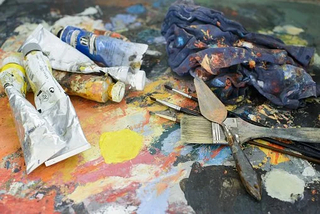
While painting with oils, I experienced chemical poisoning, not just from that but also from being a hairdresser at the time and not being careful with handling chemicals. I chose to wash my brushes in turpentine and use my bare hands to scrub them, which did not help!
Most visual artists encounter paints daily that are often toxic and dangerous to our health.
This is especially true if you work in confined spaces or have been exposed to them for an extended period.
But you also need to consider your paints' impact on the environment when choosing what you want to work with.
Oil paints, watercolour paints, and acrylic paints have different environmental impacts. Nowadays, there are more environmentally friendly paints than ever before.
In fact, several art supply manufacturers are producing paints and pigments that are environmentally safe and more health-conscious. As a result, it's possible to find organic and eco-friendly products and chemical-based ones that are less toxic.
Oil Paints
You can switch from linseed to walnut oil if you use oil paint as your medium. Artists have used it for centuries. It is superior to linseed oil in terms of not yellowing or cracking and being easier to manipulate. In this case, there's no need for chemical solvents either, as it makes it easy for paint to slide off the brush.
Take a look at M Graham & Co, a fine art supply company where you will find safe, high-quality, solvent-free oils, acrylics and watercolour paints. M. Graham has returned to the traditional art of hand-crafted, small-batch paint, utilising the historic natural bases of walnut oil and honey in their range.
Acrylic Paints
There are a lot of acrylic paint ranges around that claim to be eco-friendly. Still, as a rule, they are better suited to children's art than to professional painters. I could only find M Graham & Co, which I consider professional quality. While acrylic is my preferred medium, I am slowly moving back to oils and watercolours.
Because I still have a lot of acrylic paints, I will continue using them for a while. Tossing my paint without using it won't reduce pollution after all.
Cleaning up with acrylic paints means they can be washed off with warm water. Still, you should also remember that most acrylic paints contain a petroleum-based polymer similar to plastic, so you should avoid washing them down the drain.
Another point to think about is when acrylic paints dry, some of their elements evaporate. As a result, water, propylene glycol, and ammonia are released into the atmosphere. In addition, some of our most common acrylic mediums will release formaldehyde as they dry.
You might not be aware that propylene glycol, a common element in acrylic paints, is harmful to the environment, despite its use in cosmetics and food production. To prevent large amounts of paint from getting into waterways, I recommend removing excess paint onto a tissue and using disposable paper palettes.
Check the contents when purchasing, as it should state if this toxic substance is present in the product.
Watercolour Paints
Let's debunk the myth that watercolours are safe because it's simply not accurate. Despite being water-based and not containing solvents, watercolour paints are not entirely eco-friendly.
Yes, they are safer than acrylics and oils. Still, many pigments contain heavy metals, which are also hazardous to the environment.
For an environmentally safer option, check out the Lute range at Jacksons Art. Natural plant pigments in this range of watercolours give this range remarkable vibrancy, lightfastness, and eco-friendly attributes.
Use Ethically Sourced or Synthetic Brushes
I began using natural fibre brushes for my art practice. My favourite brush for watercolour and oil painting is a high-quality sable brush, and I love hog hair for its textured brush strokes. However, after I began working with acrylics, I preferred the look of less visible brush strokes, which introduced me to synthetic bristles and their endless possibilities.
Most of the brushes I own are sourced from Rosemary & Co, a company based in the UK. I have had some brushes from them for years. They are of exceptional quality, and I've taken good care of them. Check out my post about brushes by clicking on the image below.
While bamboo brushes are obviously more eco-friendly than brushes made from plastic, if you take good care of them, you won't need to dispose of them in the environment. Most high-quality paintbrushes are made with wooden handles; the plastic part is in the bristles.
For my watercolour work, I invest in high-quality 'Caseneo' brushes from DaVinci's range of artist brushes. The synthetic fibres on these brushes mimic squirrel hair brushes exceptionally well. As any experienced watercolourist will tell you, one of the most critical aspects of watercolour is using high-quality brushes.
Dispose of Waste Art Materials Properly
Make sure you dispose of your art supplies with the utmost care when you get rid of them. For example, although watercolours are the least bad option for eco-friendliness, they're only sometimes what an artist wants to use as I mentioned before, they can contain heavy metals.
Since oil paints aren't water-soluble, you'll usually need toxic paint thinners and turpentine to clean your brushes. A good option is to use artists' soap. This soap usually contains citrus oils, so it smells slightly better.
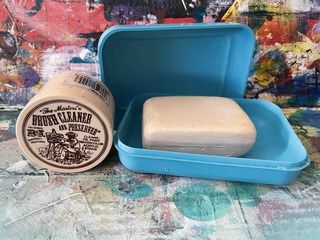
When I work with oils, I use a tissue to wipe off excess paint from my brush. The remaining debris can be removed from the bristles using the artists' soap and warm water. I also use disposable paper palettes to avoid using chemicals to clean up my palette.
If artists' soap isn't cutting it for you, then a citrus-based cleaner may be what you are after. It can be found here CITRUS CLEANER It is effective for cleaning brushes and works wonders on sticky situations around the house and in the office. Trust me, I've used it to remove many sticky labels and messes. While this product is not necessarily solvent-free, it is a gentle alternative to other more caustic options.
If you need help with how to dispose of solvents, call your local fire department. They will be able to advise you on where to take them or what to do with them.
Put solvent-soaked rags and papers in a metal container. Do not use plastic containers since many solvents will dissolve them. And you should never leave solvent-soaked rags lying around in the hot sun since they can explode and cause fires. Instead, at the end of the day, hang them in a safe place outdoors to allow evaporation.
Recycling and Upcycling with Your Art Materials
Consider recycling old canvases. I am sure you, like me, have a pile in storage of failed artwork that only needs a few coats of gesso to be 'new' again.
Remember, too, that you can paint on just about anything! If you don't want to buy canvas or art paper, you can always paint on recycled paper, wood panels, old cardboard, or even fabric scraps. With a bit of imagination, you can upcycle almost anything into art.
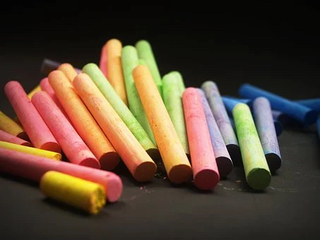
Another thing you can recycle is the dust off chalk pastels. You can collect and recycle the falloff. Adding a little water to this and
compressing it in a mold will bind it again, and then you can roll it into sticks to reuse.
Sharpen your art blades if you use them rather than dispose of them. Knife sharpeners are easy to come by, and it only takes a little effort to refresh a blunt edge and use it many more times.
Start Using Sustainable Packaging Materials
There are many packaging materials available today that are made with recycled materials. You can also recycle and reuse packaging material you have previously used.
When curating exhibitions, I made sure artists labelled their packaging so it could be reused if we returned their work. This way, the gallery saved money and time by investing in less packaging since the boxes and bubble wrap were already the correct sizes. This prevented more plastic and waste from being thrown away and polluting the environment. And it saved time too.
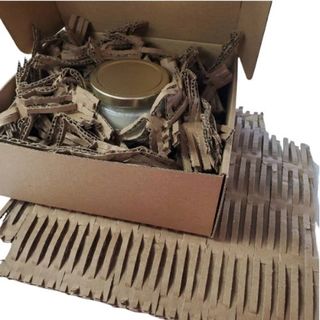
The Corrugated Bubble pictured above is the most effective alternative to traditional plastic bubble wrap. It is made entirely from post-consumer and post-industrial waste and is made of 100% recycled cardboard. The packaging is also curbside recyclable and biodegradable. You will still get the softness, protection, and safety against the impacts you want.
Styrofoam, bubble wrap, and cardboard boxes can all be reused. You likely have many of these lying around if you get a lot of frame or portrait orders. Storing and reusing them when it's time to ship your work will help the environment.
Also, don't be afraid to grab some of these items from a trash pile if you don't have many. There are many cardboard recycling bins around, and people are okay with you taking some of it if you ask nicely.
To buy new packaging, including the corrugated bubble, check out Eco Enclose for a variety of eco-friendly packaging that you can use for packaging art.
Try Making Your Own Paints, Paper and Other Art Supplies
You may have seen art movies like Girl with a Pearl Earring or the Leonardo Mini Series, where the artists ground their own pigments and made their own paints.
I know it is more challenging than it sounds. However, you want to be environmentally aware and start practising sustainability as an artist. In that case, this can be a helpful way to do your bit. It would also be fun says she who hasn't tried it yet! But hey, optimism is essential.
If you want to purchase high-quality pigments to make your own paints, check out this site: Earth Pigments, as they supply non-toxic pigment powders and mica products made from minerals.
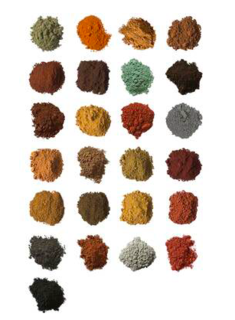
And there are many tutorials on how to make your own paint. These are obviously designed to be different with each type of paint, but here are some basic tutorials on acrylic and oil paints from Wikihow -
https://www.wikihow.com/Make-Acrylic-Paint
https://www.wikihow.com/Make-Oil-Paint
What about Paper?
You can make your own from recycled materials and other types of paper, which opens up a world of creative possibilities. All you need is an old blender, a few screens, and some know-how. Having personally tried this, I found the results fascinating and unique.
As I use mixed media in my paintings, having access to different paper types is invaluable. But unfortunately, getting different kinds of paper, especially art or craft-type ones, has become increasingly challenging here in New Zealand. So making your own is a good idea right!
Think about how you can add interesting textures with things like fabric, seeds, pressed flowers, grasses, glitter, loose thread or, in fact, anything you might be throwing away. The ideas are limitless.
Here is a tutorial on how to make your own paper, and from there, you can experiment to create unique papers for your own art practice.
There are tutorials on how to make paper without a blender and/or screen. Still, this one creates much better paper and covers the process generally.
And for a more comprehensive look at making eco-friendly art supplies, this book covers much more for an artist wishing to be more sustainable.
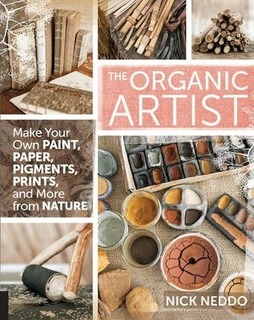
Utilise Other Eco-friendly Supplies
As artists, we should consider everything we use. There are more earth-friendly and natural options than we realise.
There are other options for painting on canvas, such as raw canvas, linen, or some synthetic blends.
I have found, however, in my search into what has the worst impact on the environment that it is fast fashion or, more to the point, cotton production. So how does this affect your canvas, you ask?
The problem is that cotton production is one of the most significant issues we face regarding its impact on the environment. A documentary I watched a while ago showed how much water is used to produce cotton and the devastating effects on lakes and waterways, completely depleting them. As most of the canvas is made of cotton, it will obviously be part of that.
With paper, there are bamboo, hemp, and flax as other options rather than cotton-based ones.
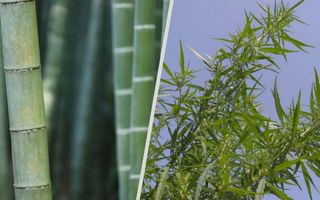
So what about bleaching? The bleaching process is one of the most detrimental aspects of creating art paper. Choosing Elemental Chlorine Free (ECF) or Totally Chlorine Free (TCF) is better. Chlorine makes the paper white but isn't vital for production.
Think about using reusable items too. For example, you can reuse rags to wipe brushes and clean up spills, and use old cups, jars or containers to dip your brushes in when needing water or mediums or cleaning up. Also, try using a paper paint palette for mixing when using acrylics and oils.
With watercolours, you don't have to buy fancy palettes; you can use an old plate to mix your paints. Most watercolour sets come with a mixing palette, but these are usually plastic, another environmental pollutant.
I strongly advocate the use of disposable paper palettes myself. These come in sheets similar to baking paper; once a session or three has finished, you simply tear off the sheet and dispose of it. This is preferable to washing down the sink.
Buying secondhand easels, palettes, smocks, and the like, can all be found secondhand if you know where to look. Check your local thrift and secondhand stores for slightly-used art supplies before you start – you might be surprised by what you find.
Then there is general cleaning, not just your house but also your art studio, leading us to available cleaning supplies. These days you can get eco-friendly cleaning products from your local supermarket. I like the Earthwise range here in New Zealand called Earth Wise, but there are many more available worldwide; they're affordable and just doing this helps the environment.
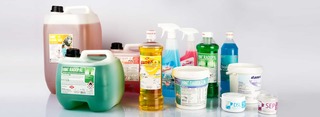
Share Unneeded art Supplies with Other Artists: but Most of all Share These Ideas
By sharing unneeded art supplies with other artists, you help cut down on environmental damage. I often find I have items I never use, or I change my mind about a product and move on to something else. So don't throw it out or wash it down the sink. Instead, offer it to your network; someone else always needs things.
End of the day, by utilising eco-friendly products and recycling as much as possible, we artists can contribute by doing our part to do right by the planet. At the same time, we create art for the world.
We all can help if we try some of these ideas and talk to each other about what we can do. Even the most minor contribution counts.
Please share this information with your circle of influence. We know other artists, and each of us wants to contribute to saving our planet. And please feel free to stay in touch, happy to chat with fellow artists.
If we all work together, we can make a difference.
Posted: Friday 11 March 2022
